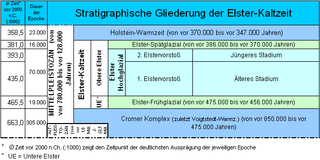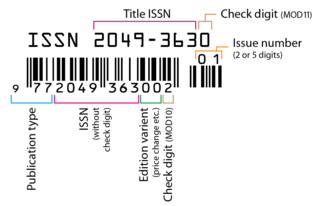The Eburonian, or, much less commonly, the Eburonian Stage, is a glacial complex in the Calabrian stage of the Pleistocene epoch and lies between the Tegelen and the Waalian interglacial. The transition from the Tegelen to the Eburonian started about 1.78 million years ago, lasted 480,000 years, its base marking the boundary between the Neogene and Quaternary deposits of the Netherlands.

There have been five or six major ice ages in the history of Earth over the past 3 billion years. The Late Cenozoic Ice Age began 34 million years ago, its latest phase being the Quaternary glaciation, in progress since 2.58 million years ago.

The Würm glaciation, in the literature usually just referred to as the Würm, often spelt "Wurm", was the last glacial period in the Alpine region. It is the youngest of the major glaciations of the region that extended beyond the Alps themselves. It is, like most of the other ice ages of the Pleistocene epoch, named after a river, the Würm in Bavaria, a tributary of the Amper. The Würm ice age can be dated to the time about 115,000 to 11,700 years ago, the sources differing depending on whether the long transition phases between the glacials and interglacials are allocated to one or other of these periods. The average annual temperatures during the Würm ice age in the Alpine Foreland were below −3 °C. This has been determined from changes in the vegetation as well as differences in the facies.
A glacial period is an interval of time within an ice age that is marked by colder temperatures and glacier advances. Interglacials, on the other hand, are periods of warmer climate between glacial periods. The last glacial period ended about 15,000 years ago. The Holocene epoch is the current interglacial. A time with no glaciers on Earth is considered a greenhouse climate state.

The Cromerian Stage or Cromerian Complex, also called either the Cromerian, Cromerian interglacial, or, rarely the Cromerian warm period, is a stage consisting of multiple glacial and interglacial periods in the Middle Pleistocene epoch. It is named after the East Anglian town of Cromer in England where interglacial deposits that accumulated during part of this stage were first discovered. The stratotype for this interglacial is the 'Cromer Forest Bed' situated at the bottom of the coastal cliff near West Runton. The 'British' Cromerian with the rank of a stage forms part of the superstage that is known as the Cromerian Complex in Europe. In Central Europe, the Cromerian Complex (Cromer-Komplex) is divided into three glacials and four interglacials, which are equivalent to Marine Isotope stages 13 to 21. In the Alpine region it may also be referred to as the Günz-Mindel interglacial, the warm period between the Günz and Mindel glaciations. In Britain, sediments deposited during the Cromerian (s.s.) precede those of the Anglian Stage and are on top of Beestonian Stage sediments. In the British isles several interglacials of 'Cromerian affinity' are known from this timeframe, one of these is the type Cromerian. Opinions of the exact correlation of British and continental Cromerian differ. Based upon the beginning of Marine Isotope Stage 21 and the end of Marine Isotope Stage 13, the Cromerian Complex started 866,000 years ago and ended 478,000 years ago.
The Yarmouthian stage and the Yarmouth Interglacial were part of a now obsolete geologic timescale of the early Quaternary of North America.

The Mindel glaciation is the third oldest glacial stage in the Alps. Its name was coined by Albrecht Penck and Eduard Brückner, who named it after the Swabian river, the Mindel. The Mindel glacial occurred in the Middle Pleistocene; it was preceded by the Haslach-Mindel interglacial and succeeded by the Mindel-Riss interglacial.
The Beestonian Stage is the name for an early Pleistocene stage used in the British Isles. It precedes the Cromerian Stage and follows the Pastonian Stage. This stage consists of alternating glacial and interglacial phases instead of being a continuous glacial epoch. It is equivalent to the Bavelian, Waalian, and Eburonian stages from the Netherlands Quaternary subdivision combined and Marine Isotope stages 22 to (60?). The Beestonian Stage and Marine Isotope Stage 22 ended about 866,000 years ago.

Marine isotope stages (MIS), marine oxygen-isotope stages, or oxygen isotope stages (OIS), are alternating warm and cool periods in the Earth's paleoclimate, deduced from oxygen isotope data reflecting changes in temperature derived from data from deep sea core samples. Working backwards from the present, which is MIS 1 in the scale, stages with even numbers have high levels of oxygen-18 and represent cold glacial periods, while the odd-numbered stages are troughs in the oxygen-18 figures, representing warm interglacial intervals. The data are derived from pollen and foraminifera (plankton) remains in drilled marine sediment cores, sapropels, and other data that reflect historic climate; these are called proxies.

The Riss glaciation, Riss Glaciation, Riss ice age, Riss Ice Age, Riss glacial or Riss Glacial is the second youngest glaciation of the Pleistocene epoch in the traditional, quadripartite glacial classification of the Alps. The literature variously dates it to between about 300,000 to 130,000 years ago and 347,000 to 128,000 years ago. It coincides with the Saale glaciation of North Germany. The name goes back to Albrecht Penck and Eduard Brückner who named this cold period after the river Riss in Upper Swabia in their three-volume work Die Alpen im Eiszeitalter published between 1901 and 1909.
The Gelasian is an age in the international geologic timescale or a stage in chronostratigraphy, being the earliest or lowest subdivision of the Quaternary period/system and Pleistocene epoch/series. It spans the time between 2.588 ± 0.005 Ma and 1.806 ± 0.005 Ma. It follows the Piacenzian stage and is followed by the Calabrian stage.
Gunz, Günz or Gunz Complex is a timespan in the glacial history of the Alps. It started approximately one million years ago and ended about 370 000 years ago. Some sources put the end at 480 000 years ago. Deep sea core samples have identified approximately 5 glacial cycles of varying intensity during Gunz.
The Waalian interglacial was an interglacial period in northern Europe that lasted from about 1.45 million to 1.20 million years ago. It thus lies entirely within the Old Pleistocene and is thus part of the Cenozoic. Its name is derived from a major branch of the Rhine delta, the Waal. The Waal warm period could correspond temporally to the Danube-Gunz interglacial of the northern Alpine Foreland.
The Haslach glaciation, Haslach Glacial Stage (Haslach-Glazial), Haslach Complex (Haslach-Komplex) and Haslach Ice Age (Haslach-Eiszeit) are historical terms for a cold period of the Pleistocene epoch. Haslach was not included in the traditional glacial schema of the Alps by Albrecht Penck and Eduard Brückner. The glacial stage was first described around 1981 by A. Schreiner and R. Ebel. Its type region is the Haslach Gravels (Haslach-Schotter) in the area of the Riß-Iller-Lech Plateau. The Haslach cold period was thought to be preceded by the Günz-Haslach interglacial and followed by the Haslach-Mindel Interglacial.
Biber or the Biber Complex is a timespan approximately 2.6–1.8 million years ago in the glacial history of the Alps. Biber corresponds to the Gelasian age in the international geochronology, which since 2009 is regarded as the first age of the Quaternary period. Deep sea core samples have identified approximately 20 glacial cycles of varying intensity during Biber.
The Biber-Danube interglacial or Biber-Danube warm period (Biber-Donau-Warmzeit) is a historical term for a hypothetical warm period of the Pleistocene epoch in the Alps, between the Biber and Danube glaciations. It was defined as an erosion phase, that followed the Biber and preceded the Danube glacial. Thus, it represented the gap between the depositions that are ascribed to the two cold periods.
The Danube-Gunz interglacial, Danube-Gunz warm period (Donau-Günz-Warmzeit), often just Danube-Gunz, or also Uhlenberg interglacial (Uhlenberg-Warmzeit) are historical terms for a hypothetical warm period of the Pleistocene in the Alps, between the Danube and Gunz glacials. The interglacial was defined as the erosion phase that followed the Danube glacial and preceded the Gunz stage. It is therefore represented by the gap between the two depositions that are attributed to the two cold periods; in the type regions of the two glacial there are various depositions. In the area of the Iller-Lech Plateau they lie between the Lower Deckschotter of the Zusam Plateau and the Intermediate Deckschotter (Zwischenschottern); in the region of the Salzach Glacier between the Eichwald Schotter and the Older Deckenschotter ; and the area of Traun and Enns between the Prägünz Schotter and the Older Deckenschotter. The erosion phase linked with this interglacial is very distinct and the composition of the gravels (Schotter) in the area east of the Rhine Glacier changes markedly.
The Gunz-Haslach interglacial and the Gunz-Haslach warm period (Günz-Haslach-Warmzeit) are historical terms for a hypothetical warm period of the Pleistocene in the Alpine region, between the Gunz and Haslach glaciations. The interglacial was defined as the erosion phase which follows the Günz and precedes the Haslach Glacial Stage. It thus corresponds to the stratigraphic gap between the Zeil gravels in Swabia and Haslach gravels northeast of the Rhine Glacier.
The Haslach-Mindel interglacial and the Haslach-Mindel warm period (Haslach-Mindel-Warmzeit) are historical terms for a hypothetical warm period of the Pleistocene in the Alpine region, between the Haslach and Mindel glacial stages. The interglacial was defined as the erosion phase which follows the Haslach and precedes the Mindel glacial stage. It thus corresponds to the stratigraphic gap between the Haslach beds and the Tannheim-Laupheim gravels northeast of the Rhine Glacier.







